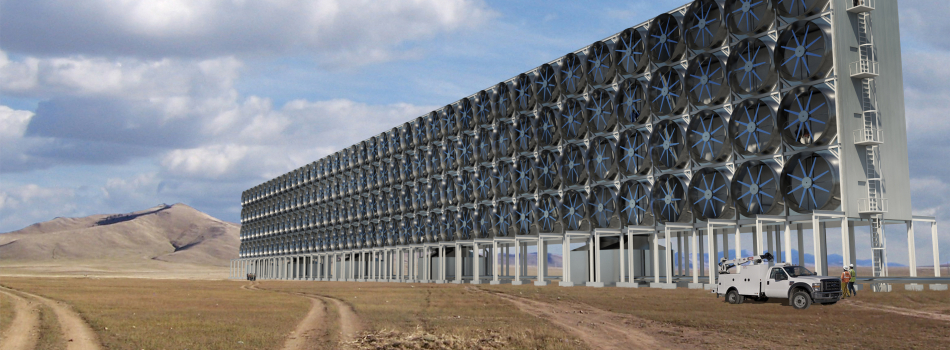If the cause of global warming is too much carbon dioxide (CO2) in the atmosphere, what if we could just capture that CO2 from the air and put it somewhere else? It’s a simple concept, but one that stretches into the experimental science-fiction edge of clean innovation.
That’s where you’ll find Carbon Engineering, a Squamish, B.C.-based company that is commercializing a technology that pulls CO2 out of the air and repurposes it as heavy-duty engine fuel.
The company essentially uses an enormous fan to suck in air from the atmosphere, passing it over corrugated sheets in a process known as Direct Air Capture or DAC. A hydroxide-based chemical solution combines with the carbon dioxide in the air, eventually binding together and turning it into a solid form.
This material can either be safely sequestered underground (which removes the carbon entirely from the atmosphere) or turned into fuels using Carbon Engineering’s Air To Fuels technology. The costs of DAC have steadily dropped to below $100 per tonne of carbon sequestered, according to the company. And the technology has been specifically designed with replication in mind, using as many off the shelf products as possible to allow it to be scaled up quickly across the world.
The fuels generated by Carbon Engineering can be used to reduce emissions from transportation without any modifications – in everything from cars and trucks to airplanes. While these fuels would still generate emissions when burned, the idea is to create a closed-loop system where carbon sequestered through the DAC process offsets the carbon emitted through transportation fuel use.
Critically, this fuel would find a ready market in jurisdictions with Low Carbon Fuel Standards such as British Columbia and California. The Canadian federal government is currently finalizing regulations to institute a similar national program across the country. These programs are designed to reduce the carbon intensity of transportation fuels, spurring innovation into cleaner alternatives.
Carbon Engineering is one of a handful of firms in the world that are competing to commercialize DAC. The technology started out as the brainchild of researcher David Keith at the University of Calgary (he’s now at Harvard). From early public-supported research and development, Keith then secured the funding to build a demonstration facility in Squamish.
Where did the money come from? On one hand, from smart government funders like Sustainable Development Technology Canada (SDTC) and B.C.’s Innovative Clean Energy Fund. And, on the other hand, from smart private investors like Bill Gates and Murray Edwards, who see big-time profit potential in this technology.
The firm recently completed a ground-breaking $90 million investment round in March 2019, bolstered by an additional $25 million from the federal government’s Strategic Innovation Fund. This has allowed Carbon Engineering to move forward with the construction of its Newport Innovation Centre in Squamish.
In May 2019, Carbon Engineering also announced that it would be teaming up with Occidental Petroleum to build the world’s largest DAC and sequestration facility in the Permian Basin. The project will begin by capturing 500 kilotonnes of atmospheric CO2 per year, eventually expanding to include multiple plants each capturing one megatonne of atmospheric CO2 annually.
With humanity emitting roughly 33 billion tonnes of carbon dioxide annually, Canada’s Carbon Engineering is showing that capturing carbon from the atmosphere has some serious potential for tackling climate change. When it comes to the economic and environmental possibility of this technology, it appears that the sky is the limit.
Read up on more Ecopreneur stories here, and follow @smartprosperity to join the #CanadasEcopreneurs conversation.



